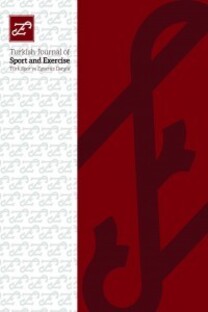The Effect of Primary School Students' Participation in Active Games involving Physical Movement on Life Satisfaction
The Effect of Primary School Students' Participation in Active Games involving Physical Movement on Life Satisfaction
___
- 1. A Agahi N. Leisure in late life: Patterns of participation and relationship with health, Unpublished doctoral dissertation, Karolinska Institutet: Aging Research Center, Department of Neurobiology, Care Sciences and Society,Stockholm, Sweden. 2008.
- 2. Anderson A, Miles A, Mahoney C, Robinson P. Evaluating the effectiveness of applied sport psychology practice: making the case for a case study approach. The Sport Psychologist, 2002. 16; 432-453.
- 3. Arlı M, Nazik H. Bilimsel araştırmaya giriş. Ankara: Gazi Kitabevi. 2004.
- 4. Auld CJ. The role of leisure in determining quality of life: Issues of content and measurement. Social Indicators Research, 2002.57(1); 43-71
- 5. Barnett LA, Storm B. Play, pleasure, and pain: The reduction of anxiety through play. Leisure Sciences, 1981.4(2);161- 175.
- 6. Basal HA. Geçmiş yıllarda Türkiye’de çocuklar tarafından oynanan çocuk oyunları. Uludağ Üniversitesi Eğitim Fakültesi Dergisi, 2007. 20 (2), 243-266.
- 7. Berg KE, Lavoie JC, Latin RW. Physiological Training Effect of Youht Soccer. Med. Sci. Sports Exerc. Dec; 1995. 17 (6), 656- 60.
- 8. Boley B. Life Satisfaction, Leisure Satisfaction and Leisure Participation Among Publicly Housed Older Adults, Unpublished doctoral dissertation, Capella University. 2001.
- 9. Broughton K, Brent BA. Leisure satisfaction of older adults, Activities, Adaptation & Aging, 2007.31(1); 1-18.
- 10. Engin AO, Seven MA, Turhan VN. Oyunların Öğrenmedeki Yeri ve Önemi. Atatürk Üniversitesi Sosyal bilimler Enstitüsü Dergisi, 2004. 4 (2); 109-120.
- 11. Ersan S. Okul öncesi eğitim kurumlarına devam eden altı yas grubundaki çocukların oyun ve çalışma algılarının incelenmesi. Yayımlanmamış Yüksek Lisans Tezi, Gazi Üniversitesi Eğitim Bilimleri Enstitüsü, Ankara. 2006.
- 12. Ersöz F. SPSS ile istatistiksel verianalizi. Ankara: Seçkin Yayıncılık. 2016.
- 13. Foret CM. Life satisfaction, leisure satisfaction, and leisure participation among young-old and old-old adults with rural and urban residence, Unpublished doctoral dissertation, Texas Women’s University, Denton,TX. 1985.
- 14. Gazezoglu Ö. Okul öncesi eğitim kurumlarına devam eden 6 yas çocuklarına öz bakım becerilerinin kazandırılmasında oyun yoluyla öğretimin etkisi. Yayımlanmamış Yüksek Lisans Tezi, Dokuz Eylül Üniversitesi Eğitim Bilimleri Enstitüsü, İzmir. 2007.
- 15. Georges R. Eğlence ve Oyunlar. MilliFolklorDergisi. Sayı: 74. 2007.
- 16. Hazar M. BedenEğitimiveSpordaOyunlaEğitim. Ankara: SarayMatbaası. 2000.
- 17. Hazar Z, Hazar K, Gökyürek B, Hazar M, Çelikbilek S. Orta okul öğrencilerinin oyunsallık, dijital oyun bağımlılığı ve saldırganlık düzeyleri arasındaki ilişkinin çeşitli değişkenler açısından incelenmesi. Journal of Human Sciences, 2017.14(4); 4320-4332.
- 18. Heller K, Procidano ME. Measures of perceived social support from friends and from family: Three validation studies, American journal of community. 1983.
- 19. Hribernik J, Mussap AJ. Research note: Leisure satisfaction and subjective wellbeing. Annals of Leisure Research, 2010.13(4); 701-708.
- 20. Huizinga J. Homo Ludens, Oyunun Toplumsal İşlevi Üzerine Bir Deneme.(Çeviren: Kılıçbay, M.A) AyrıntıYayınları. 2006.
- 21. Isenberg JP, Jalongo MR. Creative Expression and Play in Early Childhood. New Jersey: Prentice Hall. 2001.
- 22. Janke M, Davey A, Kleiber D. Modeling Change in Older Adults’ Leisure Activities. Leisure Sciences. 2006. 28(3); 285- 303.
- 23. Jim CY, Chen WY. Leisure participation pattern of residents in a new chinese city, Annals of the Association of American Geographers, 2009. 99(4); 657-673.
- 24. Kaptan S. Bilimsel Araştırma ve İstatistik Teknikleri. Ankara: Özkan Matbaacılık. 1995.
- 25. Kerkez F, Kalkavan A, Öztürk M. Bazı psikomotor ve fiziksel özelliklerin koordinatif yeteneğe etkisinin van’lı 9-11 yaş grubu erkek çocuklar üzerinde araştırılması, Spor Araştırmaları Dergisi, 2001.5(1); 19-28.
- 26. McGuinn K, Mosher-Ashley P. Participation in recreational activities and its effect on perception of life satisfaction in residential settings, Activites, Adaptaion and Aging, 2001.25(1); 77-86.
- 27. Nikfarjam P. Mathematics and Play: Analyzing The Growth Of Early Elementary Mathematical Understanding Through An Enactivist Perspective. Graduate Program In Education York, University Toronto, Ontario. 2012.
- 28. Nordqvist D. Physical Activity Levels in Children and Youth. The Degree of Master of Science, Dalhousie University. 2003. 29. Özdogan B. Çocuk ve Oyun (3.Baskı).Ankara: Anı Yayıncılık. 2000.
- 30. Öztürk H. Antrenörlük ve Spor Yöneticiliği Bölümlerinde Okuyan Öğrencilerin Fiziksel Aktivite İçeren Oyunları Oynamaya Yönelik Tutumları, Gaziantep University Journal of Social Sciences, 2016. 15(2); 717-728.
- 31. Razon N. Okul öncesie ğitimde oyunun ve oyunda yetiksinin işlevi. Okul Öncesi Eğitimi ve Yaygınlaştırılması Semineri Dergisi, 1985. 2 (3); 57-64.
- 32. Riddoch C, Boreham B. Physical activity, physical fitness and childrens health: Current concepts. In: Paediatric Exercise Sience and Medicine. Armstrong N. and Van Mechelen w, editors. Oxford, UK: Oxford University Pres, 2000. 243–252.
- 33. Sevil T. Terapatik Rekreasyonel Aktivitelere Katılımın Yaşlıların Algıladıkları Boş Zaman Tatmini, Yaşam Tatmini ve Yaşam Kalitesine Etkisi, Doktora Tezi Anadolu Üniversitesi Sağlık Bilimleri Enstitüsü Beden Eğitimi ve Spor Anabilim Dalı, Eskişehir. 2015.
- 34. Sevinç M. Erken Çocukluk Gelişimi ve Eğitiminde Oyun. İstanbul: Morpa Kültür Yayınları. 2004.
- 35. Stamatakis E, Hillsdon M, Primatesta P. Domestic physical activity in relationship to multiple CVD risk factors. American Journal of Preventi and Medicine, 2007. 32 (4); 320- 327.
- 36. Tkachuk G, Leslie-Tosgood A, Martin GL. Behavioral assessment in sport psychology. The Sport Psychologist, 2003.17; 104-117.
- Yayın Aralığı: 3
- Başlangıç: 1999
- Yayıncı: Selçuk Üniversitesi, Spor Bilimleri Fakültesi
Ali ERDOĞAN, Erkan Faruk ŞİRİN, Pınar KARACAN DOĞAN, Ahmet Azmi YETİM
Individual Innovativeness Levels of University Student
The Effect Of Basketball Training On Agility Of Children
Şirin PEPE, Kadir PEPE, Hamdi PEPE
The Acute Effects of Dynamic and Static Stretching on Tennis Serve Targeting Performance
Bahar YILMAZ, Bulent TURNA, Asuman ŞAHAN
Examination Of Sport Managers' Self-Efficacy Status And Time Management
Azmi YETİM, Ali ERDOĞAN, Erkan Faruk ŞİRİN, Pınar KARACAN DOĞAN
